SKODA FABIA 2016 3.G / NJ Workshop Manual
Manufacturer: SKODA, Model Year: 2016, Model line: FABIA, Model: SKODA FABIA 2016 3.G / NJPages: 196, PDF Size: 31.86 MB
Page 51 of 196

Failure of the KESSY system
If there is a fault in the KESSY system, the appropriate error message is dis-
played in the instrument cluster.
Low voltage of the key battery
If the voltage of the key battery is too low, a message appears in the display of
the instrument cluster referring to the need to replace the battery. Replace
the battery » page 159.
Anti-theft alarm system
Introduction
This chapter contains information on the following subjects:
Alarm trigger
49
Interior monitor and towing protection
49
The alarm system triggers audible and visual signals if an attempt is made to
break into the vehicle (hereafter referred to as alarm).
The alarm system is activated automatically approximately 30 seconds after the vehicle is locked. This is automatically disabled after release.
CAUTION
Before leaving the vehicle, check that all doors and windows are closed in or-
der to ensure that the alarm system is fully operational.
Note
The alarm system has its own power source, service life of which is 5 years.
Alarm trigger
Read and observe
on page 49 first.
The alarm is triggered when one of the following unauthorised actions is acti-
vated on the vehicle with an activated warning system. ▶ Opening the bonnet.
▶ Opening the boot lid.
▶ Opening the doors.
▶ Manipulation of the ignition lock.
▶ Towing the vehicle.
▶ Movement in the vehicle.
▶
Sudden and significant voltage failure of the electrical system.
▶ Uncoupling the trailer.
An alarm is triggered also when the driver's door is unlocked and opened by
the lock cylinder.
The alarm is switched off by pressing the
button on the key or switching on
the ignition.
Interior monitor and towing protection
Fig. 36
Button for interior monitor and
towing protection
Read and observe on page 49 first.
As soon as the interior monitor detects movements inside the locked vehicle,
it triggers the alarm.
As soon as the anti-towing protection detects tilts in the locked vehicle, it
triggers the alarm.
Both systems should be deactivated if there is a possibility that the alarm will
be triggered by movements (e.g. by people or animals) within the vehicle inte-
rior or if the vehicle has to be transported (e.g. by train or ship) or towed.
Deactivating
›
Switch off the ignition and open the driver's door.
›
Press the button on the centre column on the driver side
» Fig. 36,the
symbol illuminates in the button.
›
Lock the vehicle within 30 seconds.
Disabling the two systems switches off SafeLock.
49Unlocking and opening
Page 52 of 196
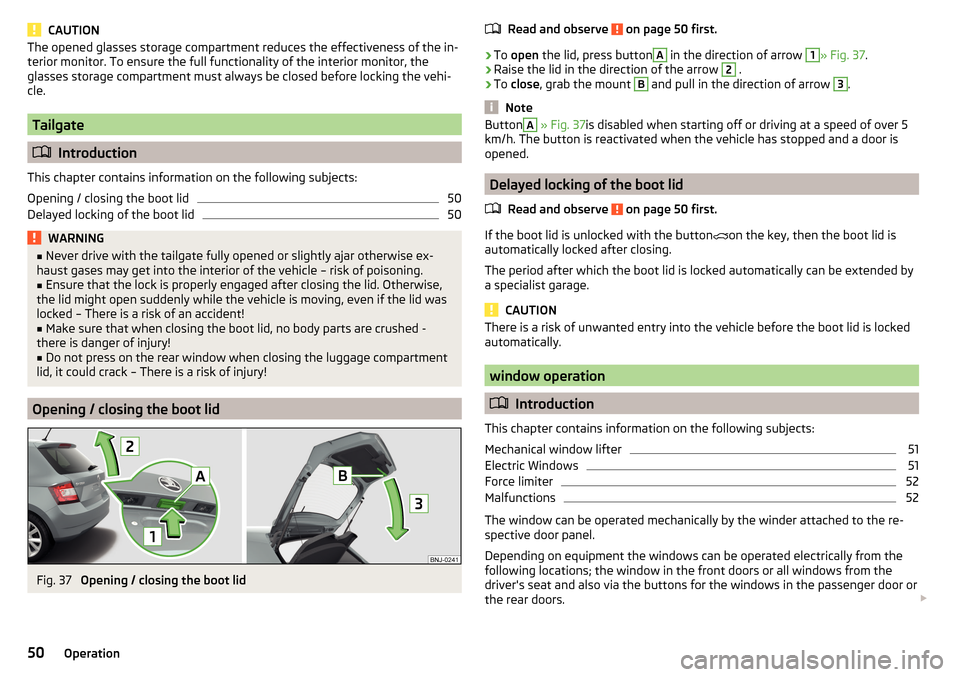
CAUTIONThe opened glasses storage compartment reduces the effectiveness of the in-
terior monitor. To ensure the full functionality of the interior monitor, the
glasses storage compartment must always be closed before locking the vehi-
cle.
Tailgate
Introduction
This chapter contains information on the following subjects:
Opening / closing the boot lid
50
Delayed locking of the boot lid
50WARNING■ Never drive with the tailgate fully opened or slightly ajar otherwise ex-
haust gases may get into the interior of the vehicle – risk of poisoning.■
Ensure that the lock is properly engaged after closing the lid. Otherwise,
the lid might open suddenly while the vehicle is moving, even if the lid was
locked – There is a risk of an accident!
■
Make sure that when closing the boot lid, no body parts are crushed -
there is danger of injury!
■
Do not press on the rear window when closing the luggage compartment
lid, it could crack – There is a risk of injury!
Opening / closing the boot lid
Fig. 37
Opening / closing the boot lid
Read and observe on page 50 first.›
To open the lid, press button
A
in the direction of arrow
1
» Fig. 37 .
›
Raise the lid in the direction of the arrow
2
.
›
To close , grab the mount
B
and pull in the direction of arrow
3
.
Note
ButtonA » Fig. 37 is disabled when starting off or driving at a speed of over 5
km/h. The button is reactivated when the vehicle has stopped and a door is
opened.
Delayed locking of the boot lid
Read and observe
on page 50 first.
If the boot lid is unlocked with the button on the key, then the boot lid is
automatically locked after closing.
The period after which the boot lid is locked automatically can be extended by
a specialist garage.
CAUTION
There is a risk of unwanted entry into the vehicle before the boot lid is locked
automatically.
window operation
Introduction
This chapter contains information on the following subjects:
Mechanical window lifter
51
Electric Windows
51
Force limiter
52
Malfunctions
52
The window can be operated mechanically by the winder attached to the re-
spective door panel.
Depending on equipment the windows can be operated electrically from the
following locations; the window in the front doors or all windows from the
driver's seat and also via the buttons for the windows in the passenger door or
the rear doors.
50Operation
Page 53 of 196
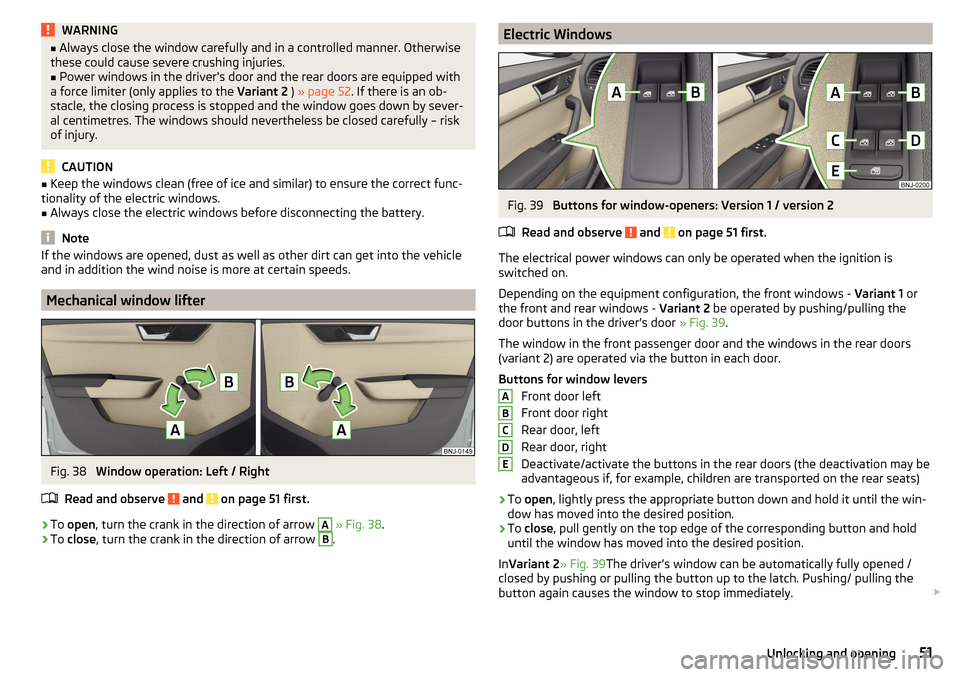
WARNING■Always close the window carefully and in a controlled manner. Otherwise
these could cause severe crushing injuries.■
Power windows in the driver's door and the rear doors are equipped with
a force limiter (only applies to the Variant 2 ) » page 52 . If there is an ob-
stacle, the closing process is stopped and the window goes down by sever-
al centimetres. The windows should nevertheless be closed carefully – risk
of injury.
CAUTION
■ Keep the windows clean (free of ice and similar) to ensure the correct func-
tionality of the electric windows.■
Always close the electric windows before disconnecting the battery.
Note
If the windows are opened, dust as well as other dirt can get into the vehicle
and in addition the wind noise is more at certain speeds.
Mechanical window lifter
Fig. 38
Window operation: Left / Right
Read and observe
and on page 51 first.
›
To open , turn the crank in the direction of arrow
A
» Fig. 38 .
›
To close , turn the crank in the direction of arrow
B
.
Electric WindowsFig. 39
Buttons for window-openers: Version 1 / version 2
Read and observe
and on page 51 first.
The electrical power windows can only be operated when the ignition is
switched on.
Depending on the equipment configuration, the front windows - Variant 1 or
the front and rear windows - Variant 2 be operated by pushing/pulling the
door buttons in the driver’s door » Fig. 39.
The window in the front passenger door and the windows in the rear doors
(variant 2) are operated via the button in each door.
Buttons for window levers Front door left
Front door right
Rear door, left
Rear door, right
Deactivate/activate the buttons in the rear doors (the deactivation may be
advantageous if, for example, children are transported on the rear seats)
›
To open , lightly press the appropriate button down and hold it until the win-
dow has moved into the desired position.
›
To close , pull gently on the top edge of the corresponding button and hold
until the window has moved into the desired position.
In Variant 2 » Fig. 39The driver’s window can be automatically fully opened /
closed by pushing or pulling the button up to the latch. Pushing/ pulling the
button again causes the window to stop immediately.
ABCDE51Unlocking and opening
Page 54 of 196

›To
deactivate/activate the buttons in the rear doors, press the E button.
When the buttons are disabled in the rear doors, the indicator light in the
button E
lights up.
Force limiter
Read and observe
and on page 51 first.
Only version 2 of the power windows is equipped with the power limiter
(does not apply to the passenger window).
If there is an obstacle, the closing process is stopped and the window goes
down by several centimetres.
If the obstacle prevents the window from being closed during the next 10 sec-
onds, the closing process is interrupted once again and the window goes down
by several centimetres.
If you attempt to close the window again within 10 seconds of the window be-
ing moved down for the second time, even though the obstacle was not yet
been removed, the closing process is only stopped. During this time it is not
possible to automatically close the window. The force limiter is still switched
on.
The force limiter is only not operational if you attempt to close the window
again within the next 10 seconds – the window will now close with full force!
If you wait longer than 10 seconds, the force limiter is switched on again.
WARNING■ Variant 1 of the power window » Fig. 39 on page 51 has no force limiter.
The windows should be closed carefully – risk of injury!■
The passenger window in variant 2 of the power window » Fig. 39 on
page 51 has no force limiter. The window should nevertheless be closed
carefully – risk of injury!
Malfunctions
Read and observe
and on page 51 first.
Repeatedly opening and closing the window can cause the window mecha-
nism to overheat and become temporarily blocked. You will be able to operate
the window again as soon as the operating mechanisms has cooled down.
The electric power windows are deactivated after the vehicle battery has been
disconnected. After connecting the vehicle battery, the system is activated as
follows.›
Switch on the ignition.
›
Pull the top edge of the button and close the window.
›
Release the button.
›
Pull up the respective button and hold for 1 second.
52Operation
Page 55 of 196
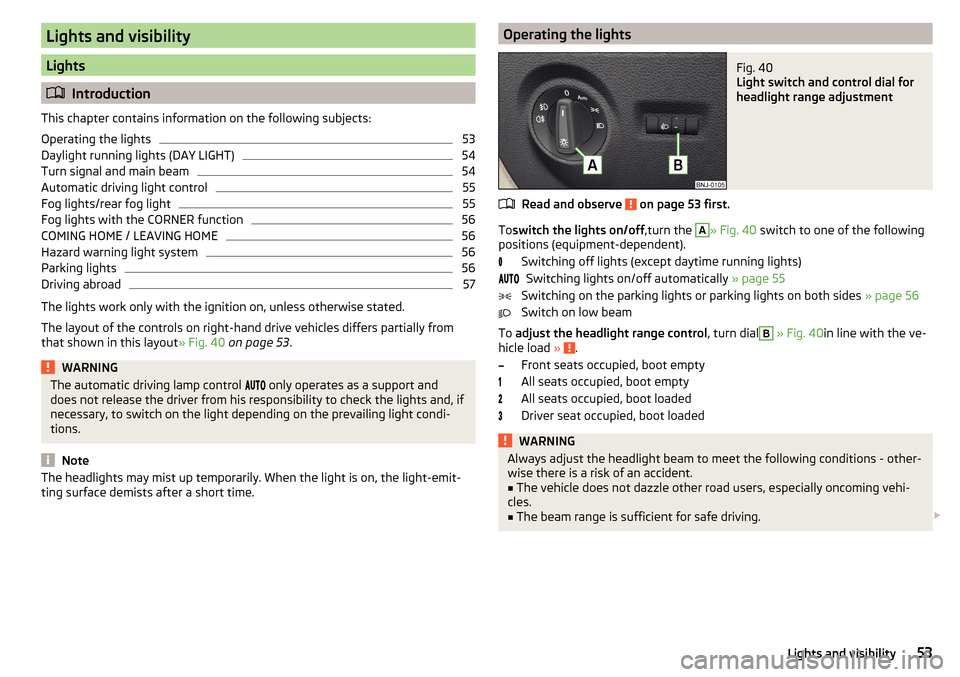
Lights and visibility
Lights
Introduction
This chapter contains information on the following subjects:
Operating the lights
53
Daylight running lights (DAY LIGHT)
54
Turn signal and main beam
54
Automatic driving light control
55
Fog lights/rear fog light
55
Fog lights with the CORNER function
56
COMING HOME / LEAVING HOME
56
Hazard warning light system
56
Parking lights
56
Driving abroad
57
The lights work only with the ignition on, unless otherwise stated.
The layout of the controls on right-hand drive vehicles differs partially from
that shown in this layout » Fig. 40 on page 53 .
WARNINGThe automatic driving lamp control only operates as a support and
does not release the driver from his responsibility to check the lights and, if
necessary, to switch on the light depending on the prevailing light condi-
tions.
Note
The headlights may mist up temporarily. When the light is on, the light-emit-
ting surface demists after a short time.Operating the lightsFig. 40
Light switch and control dial for
headlight range adjustment
Read and observe on page 53 first.
To switch the lights on/off ,turn the
A
» Fig. 40 switch to one of the following
positions (equipment-dependent).
Switching off lights (except daytime running lights)Switching lights on/off automatically » page 55
Switching on the parking lights or parking lights on both sides » page 56
Switch on low beam
To adjust the headlight range control , turn dial
B
» Fig. 40 in line with the ve-
hicle load » .
Front seats occupied, boot empty
All seats occupied, boot empty
All seats occupied, boot loaded
Driver seat occupied, boot loaded
WARNINGAlways adjust the headlight beam to meet the following conditions - other-
wise there is a risk of an accident.■
The vehicle does not dazzle other road users, especially oncoming vehi-
cles.
■
The beam range is sufficient for safe driving.
53Lights and visibility
Page 56 of 196
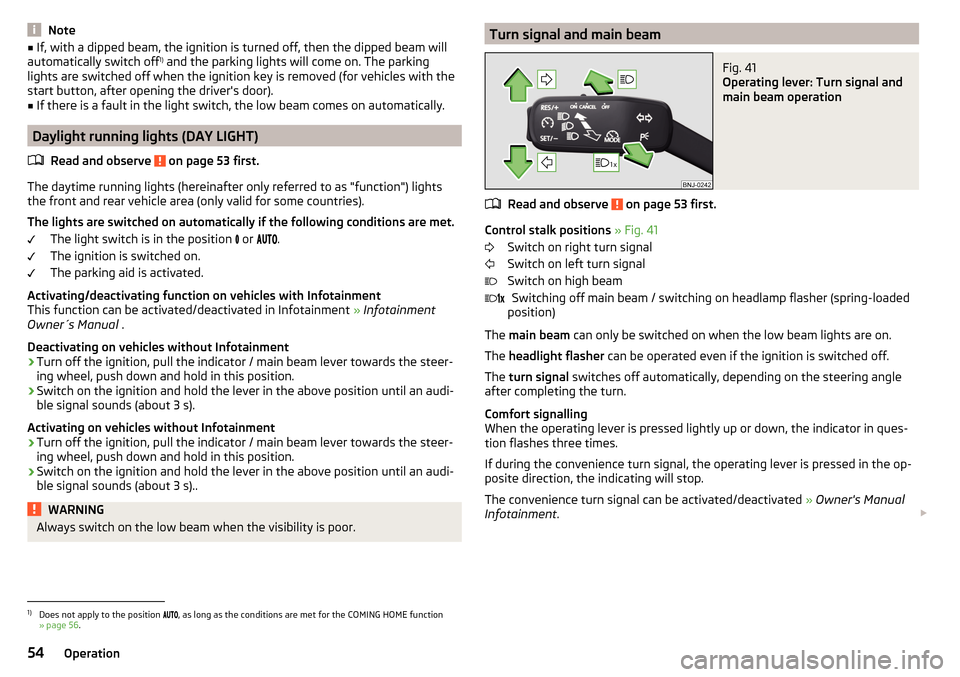
Note■If, with a dipped beam, the ignition is turned off, then the dipped beam will
automatically switch off 1)
and the parking lights will come on. The parking
lights are switched off when the ignition key is removed (for vehicles with the
start button, after opening the driver's door).■
If there is a fault in the light switch, the low beam comes on automatically.
Daylight running lights (DAY LIGHT)
Read and observe
on page 53 first.
The daytime running lights (hereinafter only referred to as "function") lightsthe front and rear vehicle area (only valid for some countries).
The lights are switched on automatically if the following conditions are met. The light switch is in the position or
.
The ignition is switched on.
The parking aid is activated.
Activating/deactivating function on vehicles with Infotainment
This function can be activated/deactivated in Infotainment » Infotainment
Owner´s Manual .
Deactivating on vehicles without Infotainment
›
Turn off the ignition, pull the indicator / main beam lever towards the steer- ing wheel, push down and hold in this position.
›
Switch on the ignition and hold the lever in the above position until an audi-
ble signal sounds (about 3 s).
Activating on vehicles without Infotainment
›
Turn off the ignition, pull the indicator / main beam lever towards the steer- ing wheel, push down and hold in this position.
›
Switch on the ignition and hold the lever in the above position until an audi-
ble signal sounds (about 3 s)..
WARNINGAlways switch on the low beam when the visibility is poor.Turn signal and main beamFig. 41
Operating lever: Turn signal and
main beam operation
Read and observe on page 53 first.
Control stalk positions » Fig. 41
Switch on right turn signal
Switch on left turn signal
Switch on high beam Switching off main beam / switching on headlamp flasher (spring-loaded
position)
The main beam can only be switched on when the low beam lights are on.
The headlight flasher can be operated even if the ignition is switched off.
The turn signal switches off automatically, depending on the steering angle
after completing the turn.
Comfort signalling
When the operating lever is pressed lightly up or down, the indicator in ques-
tion flashes three times.
If during the convenience turn signal, the operating lever is pressed in the op-
posite direction, the indicating will stop.
The convenience turn signal can be activated/deactivated » Owner's Manual
Infotainment .
1)
Does not apply to the position , as long as the conditions are met for the COMING HOME function
» page 56 .
54Operation
Page 57 of 196

WARNINGOnly turn on the main beam or the headlight flasher if other road users will
not be dazzled.
Automatic driving light control
Fig. 42
Light switch: AUTO position
Read and observe on page 53 first.
The light switch is in position
» Fig. 42 then depending on the equipment
the automatic switch on / off the lights corresponding to the light or weather
conditions (rain) takes place.
If the light switch is in position
, the lettering
illuminates next to the
light switch. If the light is switched on automatically, the symbol
also illumi-
nates next to the light switch.
Automatic driving light control in the rain (hereafter referred to as function)
The dipped beam is switched on automatically if the following conditions are
met.
The parking aid is activated.
The light switch is in the position
.
The windscreen wipers are on for more than 15 s.
The light turns off automatically about 4 minutes after turning off the wipers.
Setting, activation/deactivation
The following functions can be set or activated/deactivated in Infotainment
» Owner's Manual .
▶ Sensitivity adjustment of the sensor for determining the lighting conditions
for automatic driving light control
▶ Automatic driving-light control during rain
CAUTIONPoorer visibility is detected by a sensor mounted below the windscreen in the
holder of the inside mirror or in the control panel. Do not cover the sensor - the
system can be affected.
Fog lights/rear fog light
Fig. 43
Light switch - Switch front/rear
fog light
Read and observe on page 53 first.
Switching on the fog lights / rear fog lights is possible if the following condi-
tions apply.
The lights switch is in position
,
or
» Fig. 43 .
›
Toswitch on thefog lights ,turn the light switch to position
1
; the warning
light
illuminates in the instrument cluster.
›
To turn on therear fog light , pull the light switch to position
2
, the indicator
light
will light up in the instrument cluster.
If the vehicle is not fitted with fog lights,therear fog light is switched on by
pulling out the light switch to the only possible setting.
The fog lights/rear fog light are switched offin the reverse order.
Note
While driving with an accessory connected to the trailer socket (e.g. trailer,
bike carrier) only the equipment is illuminated by the fog light. The towing de-
vice must be installed at the factory or from the ŠKODA original accessories.55Lights and visibility
Page 58 of 196
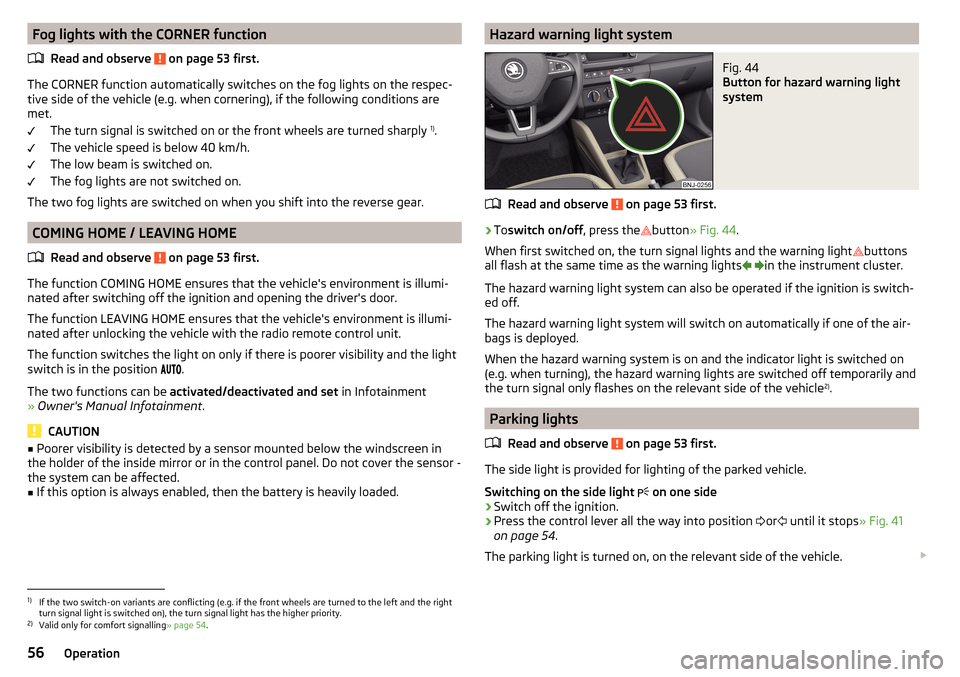
Fog lights with the CORNER functionRead and observe
on page 53 first.
The CORNER function automatically switches on the fog lights on the respec-tive side of the vehicle (e.g. when cornering), if the following conditions are
met.
The turn signal is switched on or the front wheels are turned sharply 1)
.
The vehicle speed is below 40 km/h.
The low beam is switched on.
The fog lights are not switched on.
The two fog lights are switched on when you shift into the reverse gear.
COMING HOME / LEAVING HOME
Read and observe
on page 53 first.
The function COMING HOME ensures that the vehicle's environment is illumi-
nated after switching off the ignition and opening the driver's door.
The function LEAVING HOME ensures that the vehicle's environment is illumi-
nated after unlocking the vehicle with the radio remote control unit.
The function switches the light on only if there is poorer visibility and the light
switch is in the position .
The two functions can be activated/deactivated and set in Infotainment
» Owner's Manual Infotainment .
CAUTION
■
Poorer visibility is detected by a sensor mounted below the windscreen in
the holder of the inside mirror or in the control panel. Do not cover the sensor -
the system can be affected.■
If this option is always enabled, then the battery is heavily loaded.
Hazard warning light systemFig. 44
Button for hazard warning light
system
Read and observe on page 53 first.
›
To switch on/off , press the
button
» Fig. 44 .
When first switched on, the turn signal lights and the warning light buttons
all flash at the same time as the warning lights
in the instrument cluster.
The hazard warning light system can also be operated if the ignition is switch-
ed off.
The hazard warning light system will switch on automatically if one of the air-
bags is deployed.
When the hazard warning system is on and the indicator light is switched on
(e.g. when turning), the hazard warning lights are switched off temporarily and
the turn signal only flashes on the relevant side of the vehicle 2)
.
Parking lights
Read and observe
on page 53 first.
The side light is provided for lighting of the parked vehicle.
Switching on the side light on one side
›
Switch off the ignition.
›
Press the control lever all the way into position
or
until it stops
» Fig. 41
on page 54 .
The parking light is turned on, on the relevant side of the vehicle.
1)
If the two switch-on variants are conflicting (e.g. if the front wheels are turned to the left and the right
turn signal light is switched on), the turn signal light has the higher priority.
2)
Valid only for comfort signalling » page 54.
56Operation
Page 59 of 196
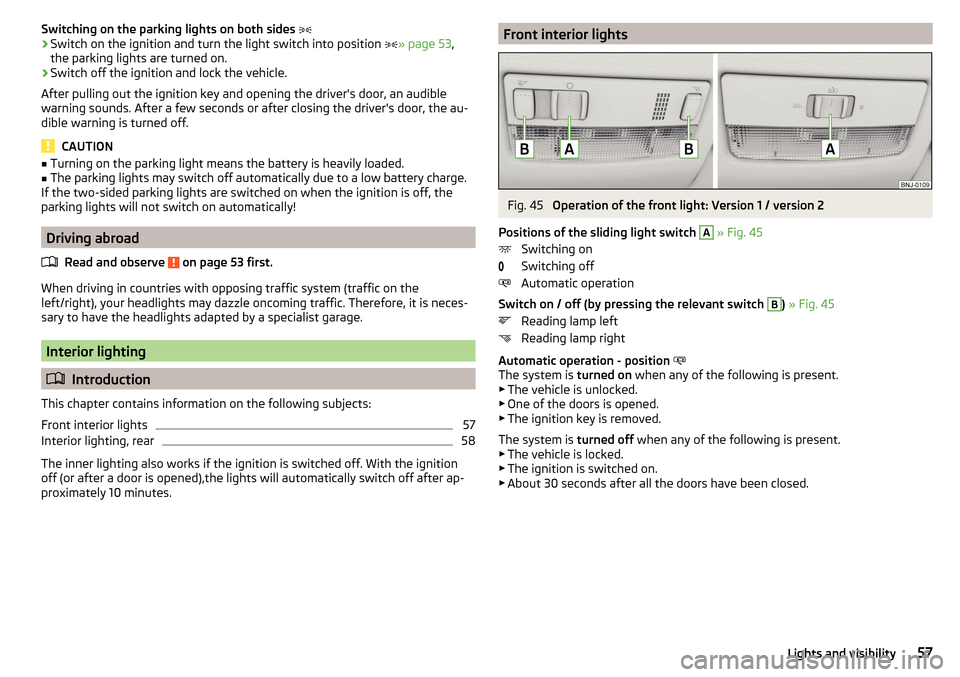
Switching on the parking lights on both sides ›Switch on the ignition and turn the light switch into position » page 53 ,
the parking lights are turned on.›
Switch off the ignition and lock the vehicle.
After pulling out the ignition key and opening the driver's door, an audible
warning sounds. After a few seconds or after closing the driver's door, the au-
dible warning is turned off.
CAUTION
■ Turning on the parking light means the battery is heavily loaded.■The parking lights may switch off automatically due to a low battery charge.
If the two-sided parking lights are switched on when the ignition is off, the
parking lights will not switch on automatically!
Driving abroad
Read and observe
on page 53 first.
When driving in countries with opposing traffic system (traffic on the
left/right), your headlights may dazzle oncoming traffic. Therefore, it is neces-
sary to have the headlights adapted by a specialist garage.
Interior lighting
Introduction
This chapter contains information on the following subjects:
Front interior lights
57
Interior lighting, rear
58
The inner lighting also works if the ignition is switched off. With the ignition
off (or after a door is opened),the lights will automatically switch off after ap-
proximately 10 minutes.
Front interior lightsFig. 45
Operation of the front light: Version 1 / version 2
Positions of the sliding light switch
A
» Fig. 45
Switching on
Switching off
Automatic operation
Switch on / off (by pressing the relevant switch
B
) » Fig. 45
Reading lamp left
Reading lamp right
Automatic operation - position
The system is turned on when any of the following is present.
▶ The vehicle is unlocked.
▶ One of the doors is opened.
▶ The ignition key is removed.
The system is turned off when any of the following is present.
▶ The vehicle is locked.
▶ The ignition is switched on.
▶ About 30 seconds after all the doors have been closed.
57Lights and visibility
Page 60 of 196

Interior lighting, rearFig. 46
Interior lights at the rear
Operation (by moving the lens
A
) » Fig. 46
Activating
Automatic operation (centre position) 1)
Switching off
Visibility
Introduction
This chapter contains information on the following subjects:
Rear window heater
58
Front sun visors
59
Panoramic roof sun shade
59WARNINGNo objects should be attached to the sun visor that could restrict the view
or endanger the vehicle occupants during sudden braking or in a collision.Rear window heaterFig. 47
Button for rear window heater
Read and observe on page 58 first.
The heater for quick defrosting and ventilation of the rear window.
The heating only works when the engine is running.
›
To switch the heating on / off,press
button
» Fig. 47 .
When the heater is switched on, a lamp illuminates inside the button.
The heating automatically switches off after 10 minutes.
Note
If the on-board voltage decreases, the heating switches off automatically
» page 142 , Automatic shutdown of consumers - vehicle battery discharge
protection .1)
In this position, the same conditions apply as for the automatic operation of the lighting from the front
seats » page 57 .
58Operation